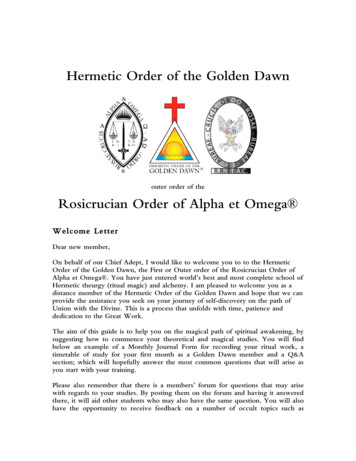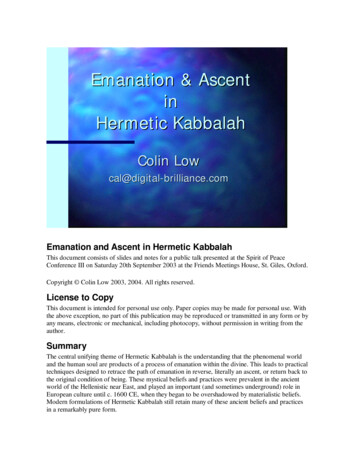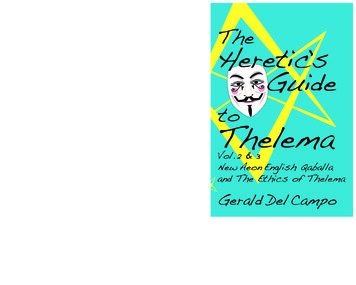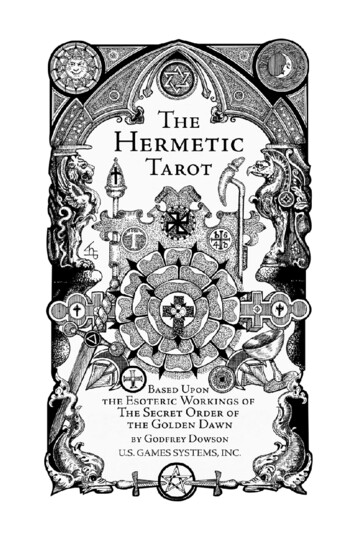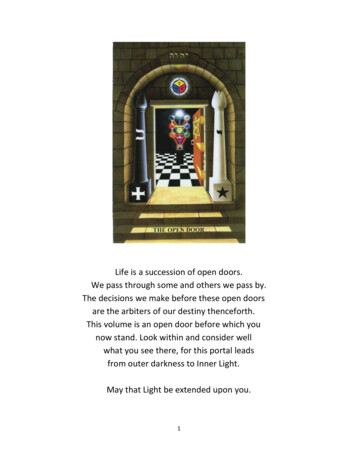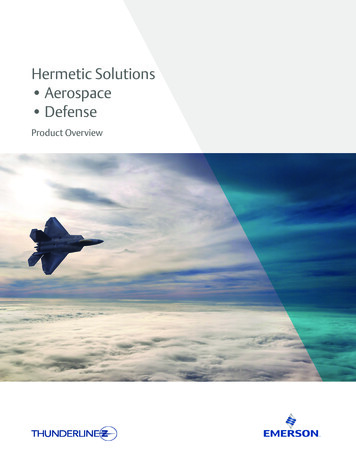
Transcription
THE HERMET'IC JOURNFTHE HERMETIC JOURNALispublishedquarterly i n Feb,May.Aug and Nov.12 Antigua Street,Edinburgh EH1 3NH.Editor : Adam McLeanA l l material copyright the individualcontributors. Material not credited i scopyright the Hermetic Journal.ISSN 0141-6391E'Contents1 Editorial3 News and Information5 Light on the Castle PathIIDeirdre Green Q12 Dew and Dew PondsPaul Baines @19 The Mythology of the QabalahP. HarrillJames @23 The Brave Old World of AlchemyPatricia Tahil Q29 Robert Fludd's Great Treatiseof Rosicrucian ScienceAdam McLean (D38 Working with PracticalAlchemy No 4Regular FeatureIII10 Alchemical Mandala No 1712 ReviewsIWith the Hermetic Journal now i n i t sfifth year of publication, and theMagnum Opus project well established with 13 titles produced i n i t sthree year span, I now feel theneed to develop further ways ofworking with the ungoing momentumthat has arisen out of this work.The Hermetic Journal i s now, Ibelieve, well known and respectedfor its serious approach to esotericism, and the solidity of the materi a l i t presents. It does not attempta 'popularisation ' of esotericism,nor does i t offer naive simplifications or present an abstract andartificial systematisation of occultphilosophy, preferring to unfold thetradition in a l l its diverse ramifications.The Magnum Opus venture providesessential source material from thewestern occult tradition, and eventually will, I hope, be seen to furnish an encyclopaedic outline ofthis tradition. These books a r e ofeconomicnecessityquitehighlypriced, and I regret that in consequence some of my subscriberscannot afford to purchase copies(however, I might just point outthat such subscribers might t r y toobtain copies through their localpublic or University Library 1.So with these two ongoing projectsfirmly founded, I am proposingtwufurther extensions of the work.17- 1
Firstly. I am to oreanise a seriesof HERMETIC J O U R ASEMINARS,Lpossi%ly yearly or half yearly, toexolore in detail certain- tooics ofinterest to my readers. h & eoneday seminars will be held inLondon and will give me the opportunity, I hope, of meeting withmany of my subscribers. Theseseminars will have a formal lecturesession and more informal discussion sessions where wecan a l lshare our ideas. For the first ofsuch seminars I have chosen thetheme of'AncientAlchemy andModern Science', and w i l l presentsome papers on the links inthought between the esoteric philosophy of the Alchemical traditionits view of matter and forces, andthe experiments and philosophicalideas underlying modern particlephysics in its pursuit of the ultimate constituents of matter. Thelinks between these two domainsw i l l be explored i n detail and Ihope that this topic w i l l providelively discussion, a s the implications of the discoveries in thedomain of high-energyphysicalscience are extremely relevant toan esoteric view of the spiritualfoundation of the natural world.Ancient alchemy and modern sciencestrangely meet in the laboratoryof the particle physicist. Each ofthe seminars w i l l be focussed upona theme, and i t would be usefulif those who attend can give somethought in advance to the ideasunderlying the theme.The other development, which Ihope some of my subscribers w i l lwish to associate themselves with.i s the CENTRE FOR ROSICRUCIANSTUDIES. As many of you w i l l havem d , historical Rosicrucianismi s one of my intense interests andconcerns. The establishment of thisformal body w i l l allow me to coordinate the work of a group ofpeople in researching this muchneglected area. There i s truly somuch to be done, that I can nolonger pursue this on my own butneed help with the ongoing projectofprovidinginsight into theworking of the Rosicrucian movement in history. This will not bean esoteric society, but a fellowship of researchers. I hope todraw potential researchers reflecting a wide range of interests andabilities into working together onspecial projects. There will be apublic face to this work in anannual ROSICRUCIAN SEMINAR inwhich some of these researches canpresented. These seminars will beopen to the general public andw i l l provide a forum for the discussion of research into Rosicrucianism.When I began publishing. theHermetic Journal over four yearsago. 1 knew that the disciplineof putting each issue together,the necessary research and thecontacts this project afforded,would be of the greatest value tome personally. This I still findso, and furthermore a momentumseems to have developed in thiswork, a n impulse that now seeksadditional ways of pursuing thisquest. I trust that you w i l l findthese parallel developments ofinterest and that I w i l l have yoursupportfortheseadditionalactivities.
THECENTREFORROSICRUCIANSTUDIESCo-ordinator : Adam McLean12 ANTIGUA STREETEDINBURGH 1SCOTLANDTel: 031 556 8200THE CENTRE FOR ROSICRUCIAN STUDIES arises out of the need to formalise a n impulse which has underlain the work of the Hermetic Journalfrom i t s inception. The Hermetic Journal h a s often focussed upon Rosicrucian material, recognising the necessity of making e a r l y texts andsymbolic diagrams available to students of occultism and promotingserious documentary research into historical Rosicrucianism.The Centre for Rosicrucian Studies will act a s a fomalised body to coordinate, and encourage people to research Rosicrucianism. I t will endour to unite a n academic historical approach with a sensitivity to theesoteric content of Rosicrucian material. It will not be a secret ordero r society but a loose-knit body of individuals sharing ideas, resourcesand research. Anyone who h a s researched this field even superficiallywill be aware of the vast stores of documents in libraries and specialcollections, t h a t have never been fully researched, and that Rosicrucianism provides a rich vein for the serious investigator.The Centre for Rosicrucian Studies will provide various resources :1) Publication of Rosicrucian material and research notes in aseries of specialist books.2 ) A free exchange of information and contacts.3) An annual meeting, probably held in London ( f i r s t to be helde a r l v in 1983) under the title :THE ROSICRUCIAN SEMINARSThese will provide a forum for people to present the fruits oftheir researches and help to stimulate further work in this field.Anyone who is in agreement with the objects of the Centre for RosicrucanStudies c a n become a n Affiliate, however, this will not be a passiveorganisation but a small active group of individuals. Affiliates to theCentre should ideally bring some positive help either through sharingthe results of their own researches, their abilities in translation, theiraccess to original documents, or other means of supporting the momentumof the research.I i is hoped that this Centre will help in some way to establish the importance of t h i s esoteric Movement for the Western Tradition, to pointi t s influence upon outer culture and history, and the relevance eventoday of the profound philosophical ideas that underlie the RosicrucianMovement.Anyone wishing to become affiliated to the Centre and helping with i t swork, please contact the co-ordinator Adam McLean.17- 3
LIGHT ON THE CASTLE PATHD E I R D R E GREEN OIt has often been made evident to me t h a t , of the f a i r l y l a r g enumber of esoteric students who use the image of the Inner Castle inmeditation, visualisation, etc., only a few a r e aware of the wide distribution of t h i s image in the experiences of mystics from different timesand cultures, and of the significance of a parallel symbolism in mythology and fairytale. I intend in this article to explore the image of thelnner Castle or Palace i n the hope that others may gain some insighto r inspiration therefrom. I will be concentrating in particular on theCastle/Palace experienced a s sevenfold, i .e., divided into seven rooms,or portrayed a s seven separate Castles/Palaces. The bulk of my illustrations will be from Jewish Hekhalot mysticism ( a forerunner ofQabbalah) and from the Spanish mystic St. Theresa of Avila. Intriguingparallels may be found in other cultures and I s h a l l p i n t some of theseout, but for reasons of brevity these cannot a l l be gone into in detail.Before proceeding to a consideration of the sevenfold Castle, however,i t may be a s well to elucidate the more general use of the symbol ofthe Castle Within, and of sevenfold stages along the way of esotericattainment.The motif of the Castle of the Inner Life i s used by many mysticsfor example, the great German mystic Meister Eckhart speaks of the"Little Castle of the Soul", the "Castle of truth", by which he denotesthe "Ground of the Soul", that innermost part of the spiritual self thati s eternally united to the Divine Life and Light. Varying the metaphor,Eckhart sometimes speaks instead of the lnner Temple, House o r Sanctu a r y , or of the strong, well-fortified City or Kingdom walled round withLight. The Inner Castle, the Ground of the Soul, i s for Eckhart pure.free, perfect unity, beyond time and space, a s ineffable and unnameablea s God himself. Here the Godhead glows and burns like a fire in a l l i t sfullness, sweetness and rapture. God, that i s , the Deity conceived a spersonal, a s possessing certain attributes and names, and so on, cannotonly the naked Godhead, the One that i s unchanging,enter this Castleabsolute Unity beyond form and beyond conceptual differentiation (the"I AM"), can enter in. But in mystical insight we may ourselves penet r a t e into this Castle, and in so doing, we surpass God insofar a s he-17- 5
i s defined, rationalized, limited : we enter the silent desert of the Godhead to be united with the pure essence of spiritual being which i s theOne. (1)The Castle a s a n image of the innermost s p i r i t u a l self h a s a numberof symbolic characteristics which may yield fruitful results if meditatedor reflected upon. Firstly, the Castle i s a holy enclosure, a temenos ;i t i s walled, defended, protected from the outside world. I t t h e r e f o r econtains the spiritual energies and forces, which radiate out from i t scentral core, the innermost self or Heart. The Castle i s the self-containedself ; the energies a r e kept under control and concentrated and consolidated in one inner "place", so a s to be available for whatever use wechoose to put them to. Secondly, because i t i s protected and enclosed,the walled Castle i s also difficult to penetrate. In mythology, i t usuallycontains within i t some treasure (denoting spiritual or magical treasure.esoteric attainment, the "pearl of great price") which i s h a r d to obtain.The unworthy and the unready a r e automatically excluded from stormingi n mythology,the Castle. Tests and ordeals must be undergone firstthe hero often has to defeat wicked or frightening monsters (aspects ofthe lower or darker self to be accepted and transformed) before he orshe can win through to the innermost central room of the Castle whichholds the Treasure. The reader may recall the t r i a l s of Arthur'sKnights of the Grail Quest - tests and ordeals undergone by a l l mysticsor Otherworld-journeyingInitiates. The enchanted Grail Castle i s asymbol of the Otherworld, and within i t dwells the Grail Keeper, themaimed Fisher King, into whose presence only a few can come. "Manya r e called, but few a r e chosen". We will note that the Kin is a magica l image of Tiphareth - a point which will be r e t u r n e d d a t e r . A goodexample of the same theme in fairytale i s 'The Sleeping Beauty'. ThePrince makes his way through the overgrown forest to the enchantedCastle where lies the sleeping (dormant) other half of his self - theinner Heart hid within thorns. In some versions of the t a l e , the trees,bushes and brambles of the forest p a r t of their own accord to let thePrince through, and close again to b a r the way to others - again wesee that only the worthy a n d appointed may approach the Castle. ( 2 )The beautiful maiden within the thorn-girt Castle represents on onelevel the anima, but also the Heart a s symbolic centre of the humansoul, which must be "awakened" from the enchanted dream to SpiritualReality. In some versions the Sleeping Beauty's name i s Briar Rose, therose again being a symbol often connected with the Heart Centre andwith the rebirth or reawakening of the true inner self. The Inner Castleof the Heart (or the Inner Temple) i s the symbolic centre of the humansoul, and the centre of the Universe - the goal of the Quest - a s i t maybe approached through the human microcosm. It lies within u s , yet isgirded round with thorns : if we do not know our own Heart, and thethorns that grow therein, we shall not pass through into the InnerTemple. We shall either grow weary of the twisting and turning of theway, or fall prey to one of the perils that l i e in wait. But if we canstand firm amidst the t r i a l s and testings of inner life. and make actualthe self knowledge that they bring, we can find a l l things within ourselves a t this still centre : for the space within this Temple i s a vastas the Cosmos itself.-When represented mythically, the Castle (or Temple, City, etc.) i soften said to be a t the centre of the Universe (Omphalos/Axis Mundi) like the World Tree. This finds i t s correspondence in the human microcosm in the identification of the Temple with the Heart Centre. The Grail6-17
Keeper, the ailing King who has to be revived, as a magical image o fTiphareth, can be seen to f i t neatly into t h i s symbolic scheme, theSephirah o f the Heart Centre being at the centre o f the middle Pillar o fthe Tree. The Castle i s the inner Self ; i r a l s o the Cosmos. Macrocosmically, it i s at the centre o f the Universe ; microcosmically, i t i sat the centre o f the s e l f . And ultimately, we are t h e Cosmoswe arethe Axis Mundi -microcosm and macrocosm are K e . "All that i s withoutthee also i s within, thus wrote Trismosin." I f we can find the tranquilcentre at the hub o f all movement that i s our innermost self - thesecret abode o f the Deity within - we shall find the centre o f theUniverse, the Axis Mundi. We enter into a new world, a world o f i n f i n ite dimensions, an enlarged sphere o f awareness whose pivotal point i sthe centre o f all l i f e and power. This experience transcends the merelyhuman to embrace all levels o f being.So much for the Castle. As for sevenfold stages o f attainment, theseare every b i t as widely represented. The stages are phases o f transformation, passages from one plane to another, sequences o f attainmento f more and more exalted levels o f consciousness, degrees o f Initiationb y which landmarks along the way are marked out. The symbol o f aladder to Heaven, having seven rungs, i s widespread. (The ladder i sitself o f t e n a World Axis symbol which, i n t u r n , connects i t with theCosmic Tree. The two sides o f the ladder can be seen as the Left andRight Pillars, unified b y the rungs.) In Mithraism, to give just oneexample, the Initiate ascends a seven-runged ladder, the rungs representing the passage o f the soul through the seven planetary heavens.Other examples o f sevenfold progression include Dante's journey throughthe seven planetary spheres i n the Paradiso, and the Sumerian myth o fthe descent o f t h e Goddess Inanna to the Nether World, i n which shepasses through seven gates. The S u f i mystic 'Attar passes through sevenvalleys to reach the hidden Palace of the King. ( 3 ) St. John o f theCross speaks o f seven degrees o f spiritual love, seven "wine-cellars" ;i n the seventh and innermost cellar we may drink o f the Beloved i n thef i n a l , intimate union. ( 4 )(Whether we regard these examples fromd i f f e r e n t traditions as referring to the same basic experience or not i simmaterial to t h e present discussion. Those who formulated these schemesof inner progress must at least have undergone very similar innerexperiences i n order to express them i n such similar terms. The readerwill be aware that the number seven has many esoteric connotations.These cannot all be mentioned here ; for our present purposes i t wills u f f i c e to say that seven i s the synthesis o f three and four, the spiritual nature and the material, hence i t denotes perfection, completeness,reintegration. I t may be symbolised b y the cube, which has s i x surfacesand a mysterious, hidden seventh point within. The six surfaces are thedirections, and we are to make ourselves into the seventh point - thestill centre from which the directions radiate. Qabbalistic traditionspeaks o f the lnner Palace located at the junction o f the s i x directionsof space which, together with t h i s centre, form a septenary. Again, theInner Palace or Castle i s the unmoving centre at the hub o f all movement.-When the symbol of the Castle/Palace unites with the sevenfold progression o f the Path, we have a potent and complex mapping-out o f aninitiatory scheme. This combined symbol, so rich i n meaning, yields i t smessage to u s i n l i f e ' s experience and i n meditation. An early Qabbalistic sevenfold division o f the Tree o f Life corresponded to the SevenPalaces which we shall now consider. The Supernal Triad o f Kether,17-7
Chokmah and Binah made up one "Palace" ; Yesod and Malkuth werecounted together a s one ; and the remaining Sephiroth had one "Palace "alloted to each. Daath, a t this stage, had not yet acquired i t s semiSephirothic status. The seventh Palace (of the Supernal Triad) i s situated in the most secret and elevated part of Heaven. The Zohar saysof i t , "There the profoundest mysteries are ; there dwells t h e a v e n l King, blessed be he, with the holy souls, and i s united with them by( 5 ) . I shall .only be able to give a summary of thea loving kissSeven Palaces in Hekhalot mysticism and St. Theresa here, but whoeverwishes to pursue the theme further w i l l find that the Sephirothic correlations w i l l yield deep insights.In the Judaic esoteric tradition. from visions like those describedin Isaiah 6, and Ezekiel 1, 8 and 10, developed Merkavah (Chariot)mysticism. The first full-scale literary presentation of this mysticism inthe post -Biblical period i s in the Hekhalot (Divine Palaces) literature(mainly circa 200-700 C.E. 1. Later, the tradition i s to some extent continued in medieval Qabbalah, and in 12th and 13th century GermanHasidism. Merkavah and Hekhalot teachings were a controversial issuein Judaism. They were kept largely secret, disclosed only to select esoteric groups, and warnings were circulated regarding the dangers oftheir misuse. The literature elaborated on the basic elements of mysticalvision a s found in the Scriptures (God sits on a throne, i n a palace ;i s surrounded by fire, wears white robes ; nearby are the Cherubimand the four Holy Creatures, etc. 1. But in Merkavah/Hekhalot mysticism.the Initiate ascends through seven Palaces ( 6 ) . Doors or gates areencountered at the entrance to each, and the Initiate needs to know thespecial means to be applied to pass through them. Two Hekhalot texts,Hekhalot Zutreti (the Small Book of the Palaces) and Hekhalot RabbatiIthe Great Book of the Palaces) describe the experiences of journeyingthrough the seven Palaces. The gate of the sixth Palace i s a particularly difficult threshold of testingthe literature contains warningsabout the dangers involved if one tries to make this crossing when notfully prepared. The mystic ( i t i s said in one fragment), when makingthe passage from one Palace to another, i s like a man who loses hisway in a wood and i s attacked by beasts which threaten to tear him topieces. Hekhalot literature gives detailed descriptions of the means andpractices by which the passages may be made - prayers, incantations,fasts, special diets, use of magical names. magical seals to be shownto Gatekeepers or to be placed on the body (71, ritual cleansing - thetexts make up a full-scale technical manual for mystical and magicalexplorers. Elaborate magical procedures are described, in particular,in Sefer Ha-Razim ( t h i s book i s divided into seven parts, correspondingto the seven Palaces) and Sefer Ha-Malbush. A l l these procedures werefor the purpose of protection and self-strengthening on the ascent ordescent ; deviation from them could mean failure a t best, or extremepsychical or physical danger (even the danger of losing one's l i f e ) a tworst. Some of the magical practices bear strong resemblence to Gnosticism.A recurrent image in Hekhalot Rabbati i s the ladder which i s useda s a means of ascent. The text says that the Initiate i s like "a manwho has a ladder in his home which he ascends and descends". Veryoften the ladder has seven rungs, corresponding to the ascent throughthe seven gates of the Palaces.An important point i s that the seven Palaces are said ( i n Hekhalot."-
Rabbati) to be inside each other. Thus to penetrate to the seventh-wouldbe to reach the Centre. We can picture this a s seven concentric circles, the journey inward being a passing through and beyondsuccessive veils (or "layers of the onion"), the truth becoming increasingly revealed (re- or un-veiled) a s we see no more through a g l a s s o rmirror but face to face. From their inner journeys, the Hekhalot I n i t i a t egained revelations and visions of the Deity and of spiritual t r u t h s , andinsight into cosmological secrets and into the secret key to the study ofthe inner meaning of the Torah (Sar-Torah). (8)Further insight into the seven Palaces may be gained from TheInterior Castle by St. Teresa of Avila. (9) Teresa was a Spanish C zmelite of the 16th century. A s we know, Spain had been a centre ofQabbalistic thought and activity for some time prior to t h i s , and i t h a sbeen conclusively shown that St. Teresa's family were of Jewish originand t h a t she tried to conceal this fact when converted to Christianity.(10)(This i s understandable in view of the intense emotions arousedi n 16th century Spain by questions of heresy. and the intense discrimination suffered there by converted Jews.) But to what extent did Teresareally abandon her Jewish heritage ? In scholarly a p p r a i s a l s of mysticism she has often been regarded a s one of the most orthodox ofChristianmystics ; but writers (although noting her Jewish background) havefailed to notice the Qabbalistic/Hekhalot elements in The Interior Castle.(11) (These do require some extraction from the main body of the text,but a r e without doubt there.St. Teresa i s therefore a n importanttransmitter of a major element in Western esoteric tradition - the sevenfold Castle/Palace.The Interior Castle was written after a vision in which Teresa seesthe soul a s a beautiful crystal o r diamond Castle, with seven mansions;in the seventh and innermost mansion dwells the King of Glory, illuminating and beautifying a l l the other mansions by his presence. Each ofthe mansions h a s many rooms and many doors o r ways of entry ; therea r e also gardens, fountains and mazes. The nearer Teresa gets to thecentre, the stronger is the Light. Outside the Castle bounds everythingis foul, dark and infested with toads, vipers and other venemous creatures (the lower aspect of the self to be overcome - the "monsters" thatthe Initiate h a s to defeat). Many souls remain in the outer court of theCastle ; they a r e not interested in entering i t , and have no idea whatis in t h a t wonderful place, o r even how many rooms i t has. Teresac a l l s the Castle a "tree of life, planted in the living waters of life"(Ps. 1 :3) - echoes of the Axis Mundi again. She uses the image of theSun to represent the God within the innermost mansion of the Castle more connections with Tiphareth, and with the centre - the Sun a scentre of the solar system, the Heart a s centre of the self. The soul,she says, may leave the spring of the living waters of life and rootitself in black, evil-smelling water. But the spring, or the brilliantSun a t the centre of the soul, do not lose their splendour and beauty(nothing can take away our essentially divine nature). But i t i s a s ifa black cloth were placed over a crystal in the sunshine, so t h a t ,although the (outer) Sun may shine upon the crystal, i t will have noeffect. The tree does not bear good fruit. The rooms of the Castle a r ein a poor state, their stewards and governors (the "faculties" of thesoul, o r the various aspects of the self) a r e blind and ill-controlled.Teresa sees the innermost seventh mansion a s surrounded by a l l theothers - our concentric circles image again. She says it i s like theempyrean heaven a t the centre. which, unlike a l l the other heavens,17- 9
-doesnot movethe unmoving quiet centre which I have described,which remains at peace beyond the buffetings of external life. "A kingi s living in his palace," says Teresa, "Many wars are waged in hiskingdom and other distressing things happen there, but he remainswhere he i s despite them all." The Interior Castle i s an account ofTeresa's stages of mystical realisation a s she roams from room to roomprogressing from the first to the seventh mansion, in which a t last sheis united with the King in Spiritual Marriage. The soul, she says, mustbe allowed to explore a l l the rooms, above, below and on either side.Each soul i s "an interior world, wherein are the many and beauteousMansions that you have seen." But again, i t i s only the worthy andprepared who can enter and explore : if we meet any resistance, wemust not try to force an entry. We have to be constantly alert for theenemies at the gate who may breach the fortress at some weak spot, andfor the venemous beasts who may t r y to reassail us. Like the Hekhalotmystics, Teresa speaks of great t r i a l s and deep sufferings i n the sixthmansion. It is a major threshold encountered after going through themystical death and rebirth i n the fifth. We cannot look back from thispoint. If we fall, we are in the depths. The sixth mansion i s a time ofpurification through suffering, through a wounding with an Arrow of Fire.A thought-provoking parallel to a l l this i s found in the East in thewritings of Ramakrishna. He also makes use of the image of a sevenroomed Palace within which, in the inmost room, dwells a King."Strangers have access only to the lower apartments ; but the prince.who knows the Palace to be his own, can move up and down from floorto floor." (12) Avataras (Divine incarnations) and others well advancedalong the Path, can climb to the roof, come down again by the stairs,and move about on the lower floors. (This I take to be a n expressionof the fact that the adept has freedom to pass back and forth acrossthe various thresholds a t w i l l . Also, that after realisation - "climbingto the roof" - we "come down again and move about on the lower floors'Lthat is, we now see the lower realm a s inherently divine, or a s manifestations of divine energy, a n d we undertake the "return to the world"to bestow upon others what has been revealed to us.) Ramakrishnaconnects his symbol of the sevenfold Palace with the seven planes ofTantric meditative and ritual practice. Contact with each of these planesproduces a specific type of spiritual experience. Tantric and Yogic writing speak of the Kundalini power, the divine energy, coiled up like aserpent at the base of the spine. By meditative exercises and otherdisciplines i t i s made to rise up the spinal column, passing through thevarious chakras, and its progress through the different stages i s characterised by distinct phases of inner experience, insights and visions.Kundalini Yoga and Tantra bear certain resemblances to Western magicalpractice (although the Eastern Chakras do not correspond exactly withthe Western centres of energy). We certainly have a very close parallelwith the Hekhalot/Qabbalistic tradition in Ramakrishna's symbol of thesevenfold Palace. This can only be explained by assuming he underwentthe same basic inner experience a s the Hekhalot mystics and St. Teresa.It i s true that lamakrishna experimented with a number of different esoteric paths, but his knowledge of the deeper aspects of the Westerntradition was minimal, and I consider it highly unlikely that he wouldhave encountered the image of the sevenfold Castle anywhere other thanin the recesses of his own inner self.The image and the inner experience of the Castle are available tous a l l ; each of us, a s St. Teresa says, i s an interior world wherein10 -17
a r e these many and beauteous mansions. We a r e each of us a microcosmembracing every level of reality, a pattern of a l l the worlds. We mustfollow the sevenfold Path to find the King in the inmost room of theCastle, to be united with the King (or to realise we a r e the King) andto rule our Inner Kingdom. The Sleeping Beauty, a t her christening.before she f a l l s into her enchanted sleep. i s given gifts by seven FairyTheGodmothers and hence has "all the perfections imaginable". (13)sevenfold Path must be followed to perfection until our sleeping soul.containing within itself in potential the synthesis of a l l seven gifts, a l lseven mansions, a l l seven powers, i s awakened. The journey i s one ofjoy, of sorrow, of danger, of great beauty, into depths where longhidden limitations and resistances must be overcome, long-lost powersreawakened. The worlds that we encounter a r e realms both of pricelesstreasure and of t r i a l s , ordeals and sufferings. The winding path thatleads to the Castle i s unknown yet dimly recognised, and opens everwider before us a s we journey along i t . May we have the courage andstrength to survive our ordeals in safety, to cross our thresholds, towin our Treasure and bring i t back to t h i s world, thus to t u r n Earthto Heaven.NOTES AND REFERENCES(1) A number of Eckhart's sermons referring to the Inner Castle can befound in Meister Eckhart : A modern Translation by Ra
19 The Mythology of the Qabalah P . Harrill James @ 23 The Brave Old World of Alchemy Patricia Tahil Q I 29 Robert Fludd's Great Treatise of Rosicrucian Science Adam McLean . ise an impulse which has underlain the work of the Hermetic Journal from its inception. The Hermetic Journal has often focussed upon Rosi- crucian material, recognising .


